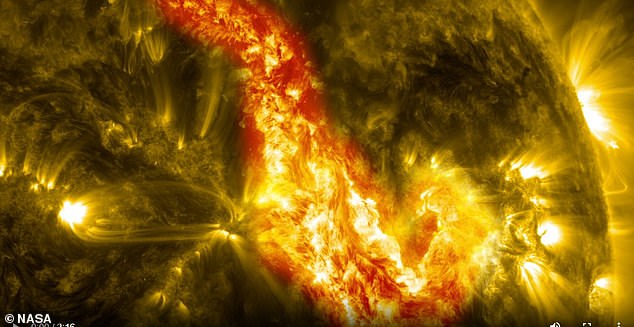
Sun’s 250,000-Mile ‘Canyon of Fire’ Eruption Sparks Solar Storm Fears
Massive Solar ‘Canyon of Fire’ Sparks Concerns Over Rising Solar Activity
By Osheen Yadav for DailyMail.com
Published: 16:37 BST, 17 July 2025 | Updated: 16:38 BST, 17 July 2025
[Image: NASA’s SOHO satellite capturing the eruption]
A colossal explosion erupted from the Sun’s surface on Wednesday, blasting a 250,000-mile-long "canyon of fire" into space. NASA satellites captured the event, which carved a glowing plasma trench stretching over 30 Earths wide, with walls towering 12,000 miles high—matching Earth’s diameter.
Solar Filament Triggers Chaos
The eruption was caused by a collapsing solar filament—a dense, magnetically anchored ribbon of material. As the filament snapped, it hurled a coronal mass ejection (CME), a massive cloud of charged particles, into space. While this CME isn’t Earth-bound, experts warn the Sun’s intensifying activity raises risks of future geomagnetic storms capable of disrupting power grids, satellites, and GPS systems.
[Image: A solar filament collapsing, creating a fiery arc]
A Growing Threat
The Sun is in an active phase of its 11-year cycle, increasing the likelihood of Earth-directed solar events. Tony Phillips of Spaceweather.com described the latest eruption’s scale: “The canyon’s walls stretch over 32,000 miles high—a grand canyon, indeed.” NOAA’s Space Weather Prediction Center reports a 60% chance of radio blackouts in the coming days due to ongoing solar volatility.
Past Precedents and Future Risks
In May 2025, a powerful solar storm sparked vivid auroras across the U.S., visible from California to Alabama, while raising concerns about infrastructure disruptions. Another recent eruption produced a 600,000-mile-wide plasma burst, twice the Earth-Moon distance.
[Image: Auroras over the U.S. from a May 2025 solar storm]
Though this week’s CME missed Earth, scientists emphasize vigilance. NASA’s Solar Dynamics Observatory continues monitoring the Sun alongside the ESA-NASA Solar and Heliospheric Observatory (SOHO), tracking potential threats.
Phillips notes: “Debris from the filament carved a fiery path, but confirmation of Earth-directed impacts awaits further data.” As solar activity peaks, the stakes for preparedness grow—reminding us of our star’s power to awe and disrupt.
[Image: Animation of a CME blasting from the Sun’s surface]
Read more about solar activity and space weather at DailyMail.com.


